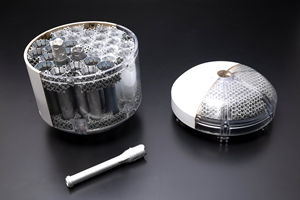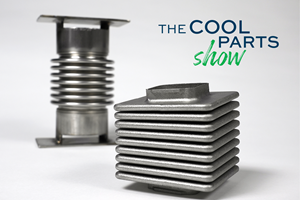Dyndrite End-User Software Expands Development for LPBF Machines
System supports multioptic build strategy operations and laser parameter control limited only by vendor openness.

Photo Credit: Dyndrite
Dyndrite has developed the company’s first end-user application focused on materials and process development for laser powder bed fusion (LPBF) machines. The software is said to give LPBF materials, part/process and applications engineers power and control over their geometry, build specific toolpathing and laser parameters, all while enabling the use of new alloys, build rate strategies and methods for printing previously unprintable parts. The software also provides native file support for a variety of LPBF machines, including Aconity, EOS, Renishaw, SLM Solutions, Trumpf and others.
“The industry previously did not have the software needed to rationally explore the opportunities provided by laser powder bed fusion processes. Users could not efficiently investigate new materials, new build strategies or even new machine architectures,” says says Steve Walton, Dyndrite head of product. “Dyndrite changes this. This new software provides a flexible new approach, a new data model, innovative and performant APIs, and complete access to toolpath geometry for those who want or need to go further.”
Dyndrite Materials and Process Development for LPBF application was designed for the needs of materials and process innovators pushing the boundaries of laser metal-based AM manufacturing. It is said to take maximum advantage of the features within the company’s Accelerated Computation Engine (ACE), including working directly with native CAD data, handling massive files, the ability to create shareable build recipes and improving print quality for various geometric features such as domes, cantilevers and thin walls.
The LPBF software takes advantage of the company’s previously announced 3D Volumetric Part Segmentation technology, which enables the detection of upskins, downskins, inskins and part features typically missed by 2.5D layer-by-layer-based solutions. Using this new geometry query method, parts, materials and machines can now be quickly qualified using geometric operations to compensate for challenges associated with process physics, the company says. Moreover, 3D volumetric segmentation means users never need to manually combine multiple build files again.
Dyndrite’s ability to save out “build recipes”' opens the door to transparent and shareable toolpathing recipes that unlock the full potential of what’s possible on LPBF machines. The company says anyone can now make a recipe and share it.
Working with CAD data directly enables seamless and automated CAD-to-print strategies that shorten print preparation, enable flexible part support strategies and speed DOE experiments.
“Dyndrite’s Toolpathing API unlocked a new dimension of flexibility for our additive manufacturing processes,” says Sam Miller, director, AM Software, AM automotive manufacturer. “The additional control over our SLM machines enables us to achieve better material performance and cost productivity in a high-quality manufacturing environment."
The Dyndrite Materials and Process Development for LPBF application is available via the company’s “Early Adopter Program” — a white-glove service offered to a limited number of customers. The LPBF software provides off-the-shelf support for leading LPBF machines, including Aconity3D, AddUp, EOS, Farsoon, Renishaw, SLM Solutions, Trumpf and others.
- Read how Dyndrite and SLM Solutions are working together to enable users to fully create SLM parameters and tool paths to fit their individual needs, maximizing materials development and application or part-specific build rate strategies.
- Learn how HP plans to use the Dyndrite Kernel to help power its next-generation, cloud- and edge-based digital manufacturing solutions.
Related Content
3D Printed Lattice for Mars Sample Return Crash Landing: The Cool Parts Show Bonus
NASA Jet Propulsion Laboratory employs laser powder bed fusion additive manufacturing plus chemical etching to create strong, lightweight lattice structures optimized to protect rock samples from Mars during their violent arrival on earth.
Read MoreVariable Resistance Valve Trim Achieves Lead Time Reduction Through AM: The Cool Parts Show #69
Baker Hughes is realizing shorter lead times and simplified manufacturing through powder bed fusion to produce valve trims previously assembled from many machined metal parts.
Read MoreDrones Take Flight with Metal and Polymer 3D Printed Parts: The Cool Parts Show Bonus
Drones produced by Cobra Aero now incorporate many 3D printed parts made through laser powder bed fusion and Multi Jet Fusion processes.
Read MoreFlexible Bellows Made Through Metal 3D Printing: The Cool Parts Show #64
Can laser powder bed fusion create metal parts with controlled flexibility? We explore an example in this episode of The Cool Parts Show.
Read MoreRead Next
Looking to Secure the Supply Chain for Castings? Don't Overlook 3D Printed Sand Cores and Molds
Concerns about casting lead times and costs have many OEMs looking to 3D print parts directly in metal. But don’t overlook the advantages of 3D printed sand cores and molds applied for conventional metal casting, says Humtown leader.
Read MoreGE Additive Rebrands as Colibrium Additive
As part of the brand name transition, both the Concept Laser and Arcam EBM legacy brands will be retired.
Read More3D Printing Brings Sustainability, Accessibility to Glass Manufacturing
Australian startup Maple Glass Printing has developed a process for extruding glass into artwork, lab implements and architectural elements. Along the way, the company has also found more efficient ways of recycling this material.
Read More










.png;maxWidth=300;quality=90)












